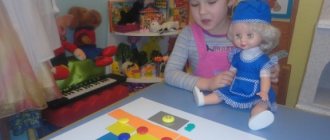Exciting experiments with magnets for children with explanations
We suggest considering experiments with magnets using ingenuity and ingenuity. For example, heat has a destructive effect on magnetic properties.
With a candle
We also propose to refute the theory that only iron is subject to magnetic influence. An exception is, for example, matches.
With matches
Let's improve the theory about the strength of a magnet a little.
Magnetic gun
We suggest creating a magnetic mechanism with your own hands.
Experiment
Using a similar algorithm, you can try different shapes of wire.
Rotation under magnetic influence
Or you can make a homemade fan! By the way, if you change the pole that touches the magnet, the direction of movement of the wire will change.
Experiment
Or you can make such an engine with your own hands.
Engine
And finally, create an almost perpetual motion machine from a magnet, a battery and copper wire (if you close the wire in a circle). Until the battery runs out. All these experiments operate on the principle of a simple electric motor - electrons move along a wire, and a force acts on them.
Magnetic train
Don't be afraid to experiment - experiments with magnets are so exciting and varied that they can surprise even adults.
Lesson summary “Magic stone - magnet” Experimentation Preparatory group
Guys, do you know where the magnet came from?I will be happy to tell you an old legend. Many, many years ago, people found a black mineral stone with a beautiful metallic sheen in the mountains. People noticed that shoes and sandals lined with iron stuck to the black stones. This natural, natural stone was called magnetite. Scientists believe that the name “magnetite” comes from the name of the city near which it was found – Magnesia.
Let's repeat what the natural stone was called, that's right guys - magnetite.
The unusual property of magnetite - to attract iron - is called magnetism. Let's repeat what the property of a stone to attract iron to itself is called - magnetism.
These magnetites quickly lose their magnetism, so a person cannot use them forever. Then people decided to make magnets from these stones that would retain the power of magnetism for a very long time, and they called them permanent, or artificial. Let's repeat what a magnet that a person creates himself is called, that's right guys - permanent or artificial.
Before we start conducting experiments, I want to remind you that you need to follow the rules of conduct. Let's remember together how to behave.
Listen carefully to the teacher.
Don't talk too loudly so as not to disturb each other.
Do not touch without permission, do not put in mouth, be careful.
Do not forget to draw a conclusion after each experiment. And we will indicate these conclusions using diagrams.
I suggest we take a closer look at this amazing stone. Let's come to the table.
What does a magnet feel like? Is the magnet light or heavy?
Let's give a definition - “A magnet is a stone, its surface is cold, smooth, has weight.....”.
Well done boys.
Let's do the first experiment.
Experiment No. 1. “What materials does a magnet attract?”
Do you think all objects are attracted by a magnet? Who believes that a magnet can attract everything to itself?
To test your assumptions, I invite everyone to come to the table. Look what objects are on the table?
I suggest you choose those objects that, in your opinion, a magnet can attract to itself.”
How to check if you made the right choice?
What objects did the magnet attract?
What items didn’t you attract?
What can be concluded?
That's right guys, they are all made of iron. This means that a magnet attracts only iron objects. Objects made from other materials are not attracted. This property of attracting objects to itself is called magnetism, from the word magnet.
Conclusion: A magnet only attracts iron objects.
Let's mark it on our diagrams.
Let's go to the next table and continue the experiments.
Experience No. 2.
“
Do magnets act at a distance?”
Guys, look, there is a line drawn on the paper, next to this line I put a paperclip. Now we will slowly move the magnet towards this line. At some distance from the line, the paperclip will suddenly “jump” and stick to the magnet; this distance must be noted.
Let's do the same experiment with other magnets. You can see that some of them are strong - they magnetize a paper clip from a farther distance, others are weak - they magnetize a paper clip from a close distance. Moreover, this distance does not directly depend on the size of the magnet itself, but only on its magnetic properties.
Guys, let's draw a conclusion.
Conclusion. There is something around a magnet that can act on objects at a distance. This something was called a “magnetic field”.
Experiment No. 3.
“Is the magnet not afraid of obstacles?”
Guys, we learned that there is a magnetic field. What do you think, if a magnet is so strong and attracts objects at a distance, does its force act through obstacles, through other materials? And who can tell me what a barrier is?
What do we have on the table?
Let us check whether the magnetic force acts through an obstacle?
There are glass mugs in front of you, you put a paper clip in the mug, I will pour water into the mugs. Now think and tell me - how to get a paper clip out of the water without getting your hands wet? How can I do that?
What can be concluded?
Conclusion: Magnetic force, a magnetic field, acts through cardboard, plastic, wood, glass and water.
Let's mark it on the diagram.
And here I have prepared a problem for you. Look carefully at this plate. What do you see in her? (Semolina) I hid something under the semolina, and you must find it, but you can’t touch the plate, you can’t pour the cereal in, or touch it with your hands. Think about how you can find a treasure, what can help you?
Well done right. Retrieve objects hidden in semolina using magnets.
Let's move on to the next table.
Experiment No. 4. “A magnet has two poles.”
How do you think two magnets will behave if they are brought close to each other? Let's check. If you take any two pieces of a magnet and bring them close to each other, it will turn out that they attract at one end and repel at the other. This means that magnets can attract or repel depending on which side you bring them to each other. One end is called the south or positive pole of the magnet and is marked with a “+” sign. The other end is the north, negative pole of the magnet, marked with a “-”. So we learned that a magnet has poles, like poles repel, and different poles attract. Let's repeat, like poles repel, and unlike poles attract.
Look at these toys: if you move the hare figurine towards the bear, the bear begins to run away from the hare. What is this focus based on? Knowing about the properties of the poles of a magnet, it is not difficult to guess that both the figure of the hare and the bear contain magnets located towards each other with the same poles.
Which scheme we will choose, which one will be correct.
What can be concluded?
Conclusion. Magnets are attracted to each other by opposite poles, and repelled by like poles. Like poles repel, and unlike poles attract.
Let's now clarify what properties of a magnet we got acquainted with today? You can tell it according to the diagram.
A magnet only attracts iron objects.
There is something around a magnet that can act on objects at a distance. This something was called a “magnetic field”.
Magnetic force, the magnetic field, operates through cardboard, plastic, wood, glass and water. Magnets operate at a distance.
A magnet has two poles, like poles repel and unlike poles attract.
Guys, what amazing stone did we get to know about the properties of today? That's right, guys with a magnet. And whoever remembers the name of the natural stone that people found in the mountains, that’s right guys - magnetite. And the unusual property of magnetite - to attract iron - is called magnetism. Well done.
Card index of experiments and games with magnets
Table of contents
PART 1. EXPERIMENTS AND EXPERIMENTS WITH MAGNETS
……………………………………………………………………………………………….. 4
EXPERIMENT 1. WHAT MATERIALS DOES A MAGNET ATTRACT?…………………………………………………………………………………………………………………………………….. 4
EXPERIMENT 2. MAGNETS ACT AT A DISTANCE……………………………………………………………………………………………………………………. .6
EXPERIMENT 3. A MAGNET HAS TWO POLES…………………………………………………………………………………………………………………………………………… ……………… 8
EXPERIMENT 4. HOW TO SEE THE MAGNETIC FIELD? ………….. 9
EXPERIMENT 5. MAGNETIC PROPERTIES CAN BE TRANSFERRED TO ORDINARY IRON……………………………………………………………………………………………… 10
EXPERIMENT 6. MAGNETIC FIELD OF THE EARTH…………………………………………………………………………………………………………………… ……………….. eleven
PART 2. GAMES WITH MAGNETS
……………………………………………………………………………………………………………………………………. 12
MAGNETIC PUPPET THEATER……………………………………………………………………………………………………………………………………………… ……….. 12
VOLUMETRIC LABYRINTH…………………………………………………………………………………………………………………………………………………… ………………………. 15
PICTURE MAZE “CAT AND MOUSE”…………………………………………………………………………………………………………………………………………… ….. 16
PENCIL POINT-MAGNETIC CONSTRUCTOR ON A CAN……………………………………………………………………………………………………………………………………. 18
FUNNY KNOCKS……………………………………………………………………………………………………………………………………… ……………………………. 19
CONCLUSION………………………………………………………………………………………………………………………………… ……………………………………. 21
3
“Introducing children to the properties of a magnet”
It can be small, big,
Iron is very friendly with him,
He will definitely help
Find a needle in a haystack.
Children's answers:
Magnet.
The teacher shows the magnet to the children and explains that a magnet is a stone.
Educator
: Take a magnet on the table and determine what it feels like?
answers :
Smooth, cold, etc.
Educator
: Do you think it is light or heavy?
answers :
Heavy.
The teacher suggests defining a magnet.
answer :
A magnet is a stone, its surface is cold, smooth, and heavy.
Educator:
What other property does a magnet have that distinguishes it from ordinary stones?
answers :
Attracts objects.
Educator:
Guys, do you think all objects are attracted by a magnet?
answers :
No.
Educator
: Let's check your assumptions.
Educator:
Take those objects that you think a magnet can attract.
Children make their own choices.
Educator:
How to check if you made the right choice? Let's conduct an experiment.
Children conduct experiments using a magnet, confirming or disproving their choice.
Experience No. 1
Educator:
Take the paper and try to attract it with a magnet. Draw a conclusion.
Children's answers
: The magnet does not attract paper.
Experience No. 2
Educator
: Take the fabric and try to attract it with a magnet.
Draw a conclusion.
answers :
The magnet does not attract fabric.
Experience No. 3
Educator:
Take a plastic spoon and try to attract it with a magnet. What conclusion can be drawn?
answers :
The magnet does not attract plastic objects.
Experience No. 4
Educator
: On your tables there are jars containing paper clip snakes. Remove the snake from the jar without putting your hand into the jar of water.
Educator:
Guys, what can we conclude?
answers :
The magnet acts through the glass.
Educator:
Let's do another experiment and find out whether a magnet only acts through glass?
Experience No. 5
Educator:
Try controlling a metal object with a magnet under a wooden table top.
Educator:
What can be concluded?
Children's answers
: The magnet acts through the wood.
Physical education moment.
Educator:
Now we will play the game
“Attracts - does not attract”
. I will throw you a ball, if the magnet attracts the object, you clap your hands. And if it doesn’t attract you, then squat.
Educator
: Which of you would like to go fishing?
The game "Fisherman"
Educator
: Do you think a magnet exhibits the property of attracting metal in water?
answers :
A magnet attracts metal in water.
The teacher draws the children's attention to a diagram that shows objects: a plastic button, a piece of fabric, paper, a pin, carnations.
MAGAZINE Preschooler.RF
Lesson summary for children 5-6 years old in the senior group “Magic properties of a magnet”Goal: to expand children's knowledge about magnets and some of its properties.
Tasks:
- Learn to examine an object and experiment with an object, highlighting its properties.
- Develop the ability to put forward hypotheses and activate children’s vocabulary.
- Get children interested in practical activities.
- Promote independence and development of communication skills.
Types of children's activities in GCD:
- Cognitive and research.
- Communicative.
- Productive
Expected results:
- Development of pupils’ cognitive interest in joint activities.
- Children's ability to act independently.
- Expansion and activation of vocabulary.
Progress of the lesson:
Educator: Hello guys!
Today we will go into the world of knowledge, discoveries, experiments and research. We will find out what a magnet is and get acquainted with its properties. Guys, does anyone know what a magnet is? What is it made of? (Children's answers).
Educator:
A magnet is made of alloys, mainly iron or steel. Any magnet, any size, even the smallest one, has a north and south pole. Different poles attract each other, and like poles repel each other.
Educator:
And now I invite you to the laboratory. How many of you know what a laboratory is? (children's answers).
Educator:
In our laboratory, you can all experiment with a magnet and various objects that are in front of you.
Educator:
To begin with, I’ll tell you why the magnet was called that.
According to an ancient legend, in ancient times, on Mount Ida, a shepherd named Magnis was tending sheep. He noticed that his iron-lined sandals and a wooden stick with an iron tip were sticking to the black stones that lay in abundance under his feet. The shepherd turned the stick upside down and made sure that the tree was not attracted by strange stones. I took off my sandals and saw that my bare feet weren’t attracted to me either. Magnis realized that these strange black stones did not recognize any other materials except iron. The shepherd took several of these stones home and amazed his neighbors. “magnet” came from the name of the shepherd .
Educator:
Guys, do you like experiments? (children's answers).
Experience No. 1
What does a magnet not attract to itself?
Children are offered: blocks of wood, pieces of fabric, plastic, rubber, polyethylene, paper.
Conclusion: the magnet is not attracted to wood, fabric, plastic, rubber, polyethylene, paper.
Experience No. 2
What is attracted to a magnet?
There are paper clips, cogs, nails, screws, coins on the table
(children conduct experiments and draw conclusions).
Conclusion: Paper clips, cogs, nails, screws, coins are attracted to a magnet.
Experience No. 3
Can a magnet act through an obstacle?
Children are given a glass of water, paper clips and a magnet. Throw a paper clip into a glass of water. Place the magnet against the glass at the level of the paperclip. After the paperclip approaches the wall of the glass, slowly move it up the wall. The paperclip follows the movement of the magnet and rises until it approaches the surface of the water (children conduct experiments and draw conclusions).
Conclusion: a magnet can act through an obstacle.
Educator:
Guys, let's play a little.
The game is called "Magnet and Paper Clips" .
Progress of the game:
I will be a magnet (show the children a magnet and how it interacts with paper clips), and you kids will be the paper clips.
The command sounds: Magnet, turned on. Children run up (paper clips) to the magnet. The command sounds: The magnet is turned off.
Children run away from the magnet and run in different directions.
The command sounds: Magnet, turned on, the children again resort to the magnet. (Repeat several times).
This concludes our laboratory's work.
And we need to remember what new and interesting things we learned about the magnet:
- A magnet is made of alloys, mainly iron or steel.
- Any magnet, any size, even the smallest one, has a north and south pole.
- Different poles attract each other, and like poles repel each other.
- That a magnet is not attracted to wood, fabric, plastic, rubber, polyethylene, paper.
- Paper clips, cogs, nails, screws, coins are attracted to a magnet.
- The magnet can act through an obstacle.
Educator:
Well done, you did a good job! You and I now know what a magnet is and its magical properties. You will be able to use your knowledge in the future when you go to school - you will learn a lot more about the magnet. I wish you success!
| Next > |



